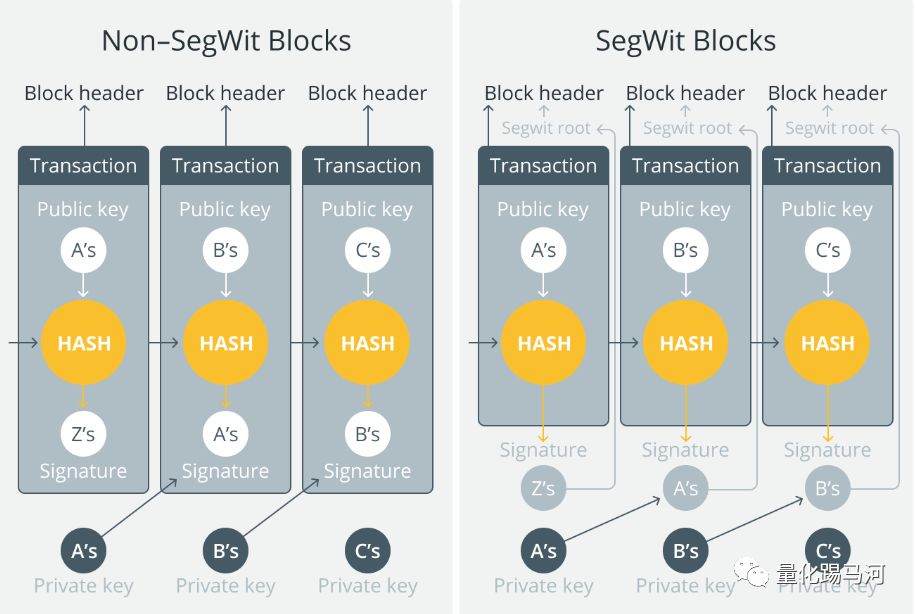Getting Started with Blockchain | Why Does Bitcoin Blockchain Need SegWit?
Author: Nikolai Kuznetsov
Compilation: Quantitative Kick Horse
SegWit, also known as Segregated Witness, is a name for the upgrade of the Bitcoin protocol, which was implemented on August 23, 2017.
As with any other distributed blockchain, if Bitcoin's algorithm needs to be updated, Bitcoin developers and participants will jointly decide how and when to update. The purpose of upgrading through this method is to help Bitcoin expand and repair vulnerabilities, as these vulnerabilities lead to the risk of having no trust in it. SegWit is known for upgrading the way data is stored on the Bitcoin blockchain. Difference between SegWit and Non-SegWit 
- Article estimates Bitcoin halving date in 2020
- Opinion: Bitcoin must return to Satoshi Nakamoto's original intention
- Learn about the giant whale grayscale investment fund and understand the encryption market trend
For centralized financial products, if the algorithms behind them need to be adjusted, only administrators or authorized institutions can directly update or modify unilaterally.
For distributed projects like Bitcoin, SegWit-like protocol upgrades only occur occasionally, and they are unique to the blockchain. Bitcoin's existence depends on its remote support from people around the world. When enough users agree to update their software in the same way, it must branch out in a new direction. Why use SegWit? The SegWit fork increases the number of transactions in any Bitcoin block.
In previous articles, hard fork and soft fork were described separately in detail. SegWit here is a soft fork, that is, the update of the blockchain without dividing the "chain" into two. This means that there will be a Bitcoin blockchain that will accept blocks from users who have enabled SegWit and those who have not yet enabled SegWit in the software.
SegWit fixes a problem called transaction malleability, which allows Bitcoin transaction data to be changed before the transaction is completed by the network. SegWit stores signature information outside the relevant block, but still guarantees that it can be verified, so that while Bitcoin maintains the integrity of the transaction, it packs more transactions into any single 1MB block. This can make the blockchain more secure and faster when processing Bitcoin transactions.
Why was SegWit not fully adopted?
Although SegWit has many benefits, it is a pity that it has not been fully adopted by all Bitcoin network participants because it is not mandatory (as mentioned earlier, it is a soft fork).
Bitcoin is not a simple "upgrade". It needs to rely on wallets. Exchanges and companies use it to upgrade themselves before pushing changes to the network. No one is forcing users to adopt SegWit, it is up to the team of engineers to push their organization in the right direction, so this often doesn't make it work as expected. When SegWit came out, only a small part of the company quickly adopted it, and some company managers were hesitant to decide whether to use new software for updates. After all, the decision on whether to adopt or not is in the technical team Hand.
Another reason is that miners prefer to use AsicBoost firmware that is not compatible with SegWit, but it is said that using SegWit can actually help them increase transaction verification speed by 20%.
Are there any disadvantages to SegWit?
SegWit gives the block more weight or transaction density, but because some blockchain data will be kept outside the original chain as a reference or index, some people think that unloading data from the blockchain is already One failed. This is also the reason for the hard fork of blockchain cash in 2017.
Can SegWit succeed?
As the volume of bitcoin transactions rises, users are increasingly inclined to adopt SegWit-enabled wallets, because these wallets have higher weights (transaction density) for processing transaction blocks, which increases speed and cost-effectiveness, and therefore forces More companies are adopting SegWit.
Since last year, the usage of SegWit has increased from 39% to more than 50.5%.
As more transactions on the Bitcoin blockchain enable SegWit, using AsicBoost firmware or filtering out these transactions is no longer a profit strategy for miners. Perhaps SegWit is only the first step for cryptocurrency developers on the right path.
We will continue to update Blocking; if you have any questions or suggestions, please contact us!
Was this article helpful?
93 out of 132 found this helpful
Related articles
- Large institutions continue to expand: Bakkt launches BTC futures contract in Singapore
- The miners began to surrender, how will the bitcoin market react?
- Twitter Featured | Encrypted Cats Entangled Ethereum, Gods Unchained can screw it up
- Analyst: There are four long-term prospects for Bitcoin, will it return to the bull market?
- Getting started with blockchain | Bitcoin's success book: How does it solve the double flower problem?
- Twitter Featured | Euro Pacific Capital CEO: The idea of turning bitcoin into digital gold is wrong
- Babbitt Column | Bitcoin White Paper 11th Anniversary: Here are 11 amazing common sense about Bitcoin



